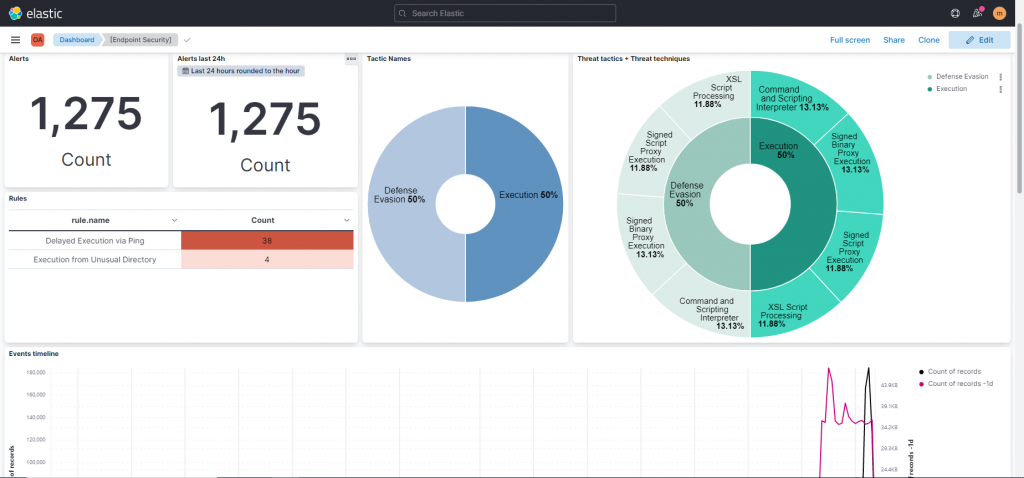We decided to carry out an evaluation of Elastic’s EDR using the APT Simulator (https://github.com/NextronSystems/APTSimulator) tool.
This tool is widely used within the cyber security community and is highly reputed, as it was developed by Florian Roth, who also created the Sigma Rule project.
APT Simulator is a Windows Batch script that uses a set of tools and output files to make a system look as if it has been compromised. In contrast to other adversary simulation tools, APT Simulator is designed to make the application as simple as possible. You don’t need to run a web server, database or any agents on a set of virtual machines. Just download the prepared archive, then extract and run the Batch file it contains as Administrator.
The following table shows the various test cases carried out by the tool along with their category.
| Test Case | Category |
|---|---|
| Collect Local Files | Collection |
| C2 Connects | Command and Control |
| DNS Cache 1 (Cache Injection) | Command and Control |
| Malicious User Agents (Malware, RATs) | Command and Control |
| Ncat Back Connect (Drop & Exec) | Command and Control |
| WMI Backdoor C2 | Command and Control |
| LSASS Dump (with Procdump) | Credential Access |
| Mimikatz 1 (Drop & Exec) | Credential Access |
| WCE 1 (Eventlog entries) | Credential Access |
| Active Guest Account Admin | Defense Evasion |
| Fake System File (Drop & Exec) | Defense Evasion |
| Hosts File (AV/Win Update blocks) | Defense Evasion |
| Obfuscated JS Dropper | Defense Evasion |
| Obfuscation (RAR with JPG ext) | Defense Evasion |
| Nbtscan Discovery (Scan & Output) | Discovery |
| Recon Activity (Typical Commands) | Discovery |
| PsExec (Drop & Exec) | Execution |
| Remote Execution Tool (Drop) | Execution |
| At Job | Persistence |
| RUN Key Entry Creation | Persistence |
| Scheduled Task Creation | Persistence |
| StickyKey Backdoor | Persistence |
| UserInitMprLogonScript Persistence | Persistence |
| Web Shells | Persistence |
| WMI Backdoor | Persistence |
The details of the various tests carried out by APT Simulator are shown below.
Collection
Collect Local Files
- Drops pwdump output to the working dir
- Drops directory listing to the working dir
Command and Control
C2 Connects
- Uses Curl to access well-known C2 servers
DNS Cache 1
- Looks up several well-known C2 addresses to initiate DNS requests and get the addresses into the local DNS cache
Malicious User Agents
- Uses malicious user agents to access web sites
Ncat Back Connect
- Drops a PowerShell Ncat alternative to the working directory and runs it to back connect to a well-known attacker domain
WMI Backdoor C2
- Uses Matt Graeber’s WMIBackdoor to contact a C2 at certain intervals
Credential Access
LSASS DUMP
- Dumps LSASS process memory to a suspicious folder
Mimikatz-1
- Dumps mimikatz output to working directory (fallback if other executions fail)
- Runs a special version of mimikatz and dumps the output to working directory
- Run Invoke-Mimikatz in memory (github download, reflection)
WCE-1
- Creates Windows Eventlog entries that look as if WCE has been executed
Defense Evasion
Active Guest Account Admin
- Activates Guest user
- Adds Guest user to the local administrators
Fake System File
- Drops suspicious executable with system file name (svchost.exe) in %PUBLIC% folder
- Runs that suspicious program in %PUBLIC% folder
Hosts
- Adds entries to the local hosts file (update blocker, entries caused by malware)
JS Dropper
- Runs obfuscated JavaScript code with wscript.exe and starts decoded bind shell on port 1234/tcp
Obfuscation
- Drops a cloaked RAR file with a JPG extension
Discovery
Nbtscan Discovery
- Scans 3 private IP address class-C subnets and dumps the output to the working directory
Recon
- Executes commands used by attackers to get information about a target system
Execution
PsExec
- Dumps a renamed version of PsExec to the working directory
- Runs PsExec to start a command line in LOCAL_SYSTEM context
Remote Execution Tool
- Drops a remote execution tool to the working directory
Lateral Movement
No test cases yet
Persistence
At Job
- Creates an at job that runs mimikatz and dumps credentials to file
RUN Key
- Create a suspicious new RUN key entry that dumps “net user” output to a file
Scheduled Task
- Creates a scheduled task that runs mimikatz and dumps the output to a file
Scheduled Task XML
- Creates a scheduled task via XML file using Invoke-SchtasksBackdoor.ps1
Sticky Key Backdoor
- Tries to replace sethc.exe with cmd.exe (a backup file is created)
- Tries to register cmd.exe as a debugger for sethc.exe
Web Shells
- Creates a standard web root directory
- Drops standard web shells into that directory
- Drops a GIF obfuscated web shell into that directory
UserInitMprLogonScript Persistence
- Uses the UserInitMprLogonScript key to get persistence
WMI Backdoor
- Uses Matt Graeber’s WMIBackdoor to kill local procexp64.exe when it starts
For our tests we used a Windows 10 client, with the latest available updates applied. The installation of the EDR Endpoint Security was carried out through the Fleet Server present within our SOC and a default policy was applied, without any particular exceptions.
Below are the results of the various tests performed and the possible detection capability by Elastic’s EDR:
| Test Case | Detection Elastic EDR |
|---|---|
| Collect Local Files | |
| C2 Connects | OK |
| DNS Cache 1 (Cache Injection) | OK |
| Malicious User Agents (Malware, RATs) | OK |
| Ncat Back Connect (Drop & Exec) | OK |
| WMI Backdoor C2 | OK |
| LSASS Dump (with Procdump) | OK |
| Mimikatz 1 (Drop & Exec) | OK |
| WCE 1 (Eventlog entries) | OK |
| Active Guest Account Admin | OK |
| Fake System File (Drop & Exec) | OK |
| Hosts File (AV/Win Update blocks) | OK |
| Obfuscated JS Dropper | OK |
| Obfuscation (RAR with JPG ext) | OK |
| Nbtscan Discovery (Scan & Output) | OK |
| Recon Activity (Typical Commands) | OK |
| PsExec (Drop & Exec) | Failed |
| Remote Execution Tool (Drop) | Failed |
| At Job | OK |
| RUN Key Entry Creation | OK |
| Scheduled Task Creation | OK |
| StickyKey Backdoor | OK |
| UserInitMprLogonScript Persistence | OK |
| Web Shells | OK |
| WMI Backdoor | OK |
Once the tool has been run from a Powershell shell with administrative privileges, you can choose which tests to run:
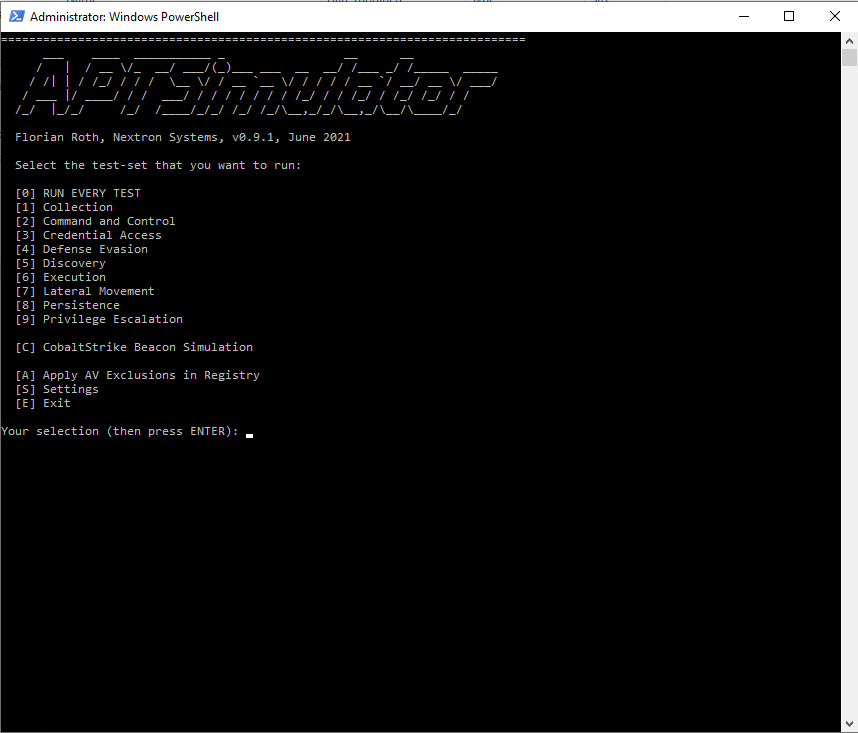
During our tests we decided to start each single test individually, so as to be able to verify the events transmitted to Elastic from time to time.
As the tool suggests, if you want to replicate these tests within your environment, we recommend that you take a snapshot of the virtual machine used.
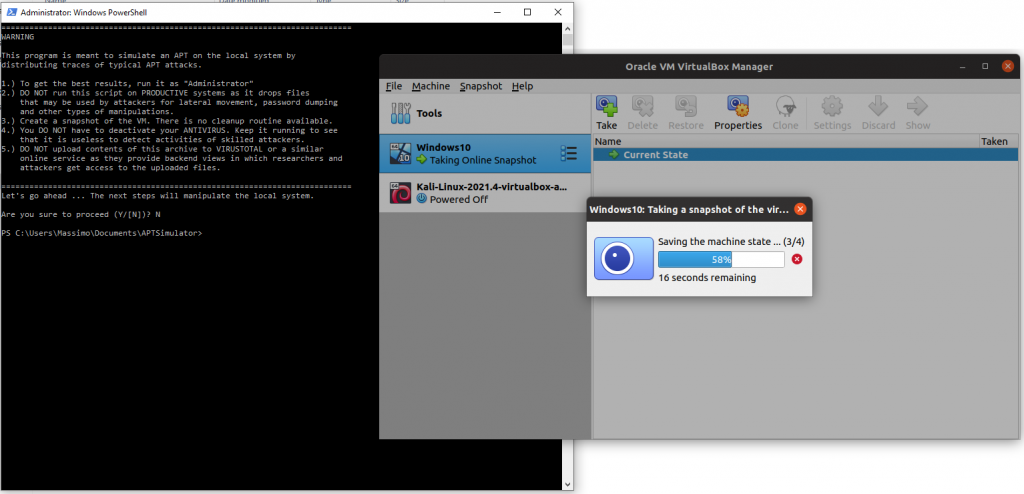
We now present the details of the detection capability of the various test categories.
Collection
This test is out of scope, as it is undetectable by EDR technology.
Command and Control
Result: Detected.
Evidence:
16:07:56.617
elastic_agent.endpoint_security
[elastic_agent.endpoint_security][info] RulesEngine.cpp:798 type: diagnostic
16:07:56.617
elastic_agent.endpoint_security
[elastic_agent.endpoint_security][info] RulesEngine.cpp:799 name: Delayed Execution via Ping
16:07:56.617
elastic_agent.endpoint_security
[elastic_agent.endpoint_security][info] RulesEngine.cpp:800 trusted: false
16:07:56.617
elastic_agent.endpoint_security
[elastic_agent.endpoint_security][info] RulesEngine.cpp:807 alert sent: true
16:07:56.617
elastic_agent.endpoint_security
[elastic_agent.endpoint_security][info] ResponseActions.cpp:86 Successfully killed process pid=13184, name=powershell.exe, result=0Credential Access
Result: Detected
Evidence:
16:09:12.437
elastic_agent.endpoint_security
[elastic_agent.endpoint_security][info] RulesEngine.cpp:798 type: diagnostic
16:09:12.437
elastic_agent.endpoint_security
[elastic_agent.endpoint_security][info] RulesEngine.cpp:799 name: Delayed Execution via Ping
16:09:12.437
elastic_agent.endpoint_security
[elastic_agent.endpoint_security][info] RulesEngine.cpp:800 trusted: false
16:09:12.437
elastic_agent.endpoint_security
[elastic_agent.endpoint_security][info] RulesEngine.cpp:807 alert sent: true
16:09:12.480
elastic_agent.endpoint_security
[elastic_agent.endpoint_security][info] BulkQueueConsumer.cpp:224 Sent 1 documents to Elasticsearch
16:09:12.521
elastic_agent.endpoint_security
[elastic_agent.endpoint_security][info] ResponseActions.cpp:86 Successfully killed process pid=8812, name=powershell.exe, result=0Defense Evasion
Result: Detected
Evidence:
16:10:37.946
elastic_agent.endpoint_security
[elastic_agent.endpoint_security][info] RulesEngine.cpp:798 type: diagnostic
16:10:37.946
elastic_agent.endpoint_security
[elastic_agent.endpoint_security][info] RulesEngine.cpp:799 name: Execution from Unusual Directory
16:10:37.946
elastic_agent.endpoint_security
[elastic_agent.endpoint_security][info] RulesEngine.cpp:800 trusted: false
16:10:37.946
elastic_agent.endpoint_security
[elastic_agent.endpoint_security][info] RulesEngine.cpp:807 alert sent: true
16:10:37.959
elastic_agent.endpoint_security
[elastic_agent.endpoint_security][info] ResponseActions.cpp:86 Successfully killed process pid=13704, name=wscript.exe, result=0Discovery
Result: Detected
Evidence:
16:11:50.130
elastic_agent.endpoint_security
[elastic_agent.endpoint_security][info] RulesEngine.cpp:798 type: diagnostic
16:11:50.130
elastic_agent.endpoint_security
[elastic_agent.endpoint_security][info] RulesEngine.cpp:799 name: Delayed Execution via Ping
16:11:50.130
elastic_agent.endpoint_security
[elastic_agent.endpoint_security][info] RulesEngine.cpp:800 trusted: false
16:11:50.130
elastic_agent.endpoint_security
[elastic_agent.endpoint_security][info] RulesEngine.cpp:807 alert sent: true
16:11:50.178
elastic_agent.endpoint_security
[elastic_agent.endpoint_security][info] BulkQueueConsumer.cpp:224 Sent 1 documents to Elasticsearch
16:11:50.341
elastic_agent.endpoint_security
[elastic_agent.endpoint_security][info] ResponseActions.cpp:86 Successfully killed process pid=9352, name=WMIC.exe, result=0Execution
Result: Not Detected
Evidence:
Persistence
Result: Detected
Evidence:
16:14:15.612
elastic_agent.endpoint_security
[elastic_agent.endpoint_security][info] RulesEngine.cpp:798 type: diagnostic
16:14:15.612
elastic_agent.endpoint_security
[elastic_agent.endpoint_security][info] RulesEngine.cpp:799 name: Delayed Execution via Ping
16:14:15.612
elastic_agent.endpoint_security
[elastic_agent.endpoint_security][info] RulesEngine.cpp:800 trusted: false
16:14:15.612
elastic_agent.endpoint_security
[elastic_agent.endpoint_security][info] RulesEngine.cpp:807 alert sent: true
16:14:15.649
elastic_agent.endpoint_security
[elastic_agent.endpoint_security][info] ResponseActions.cpp:86 Successfully killed process pid=12888, name=powershell.exe, result=0
From the point of view of the end user, the detections are displayed through the integration of the EDR in the notification system of the operating system.
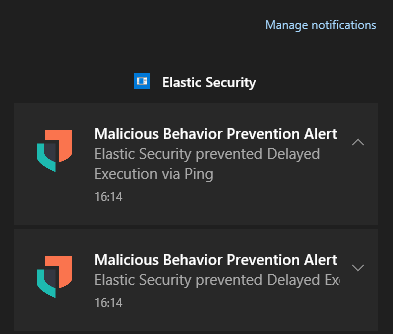
While from the point of view of the SOC cyber security analysts it’s possible to obtain evidence of the various attack actions by activating the detection rule available by default within Elastic.
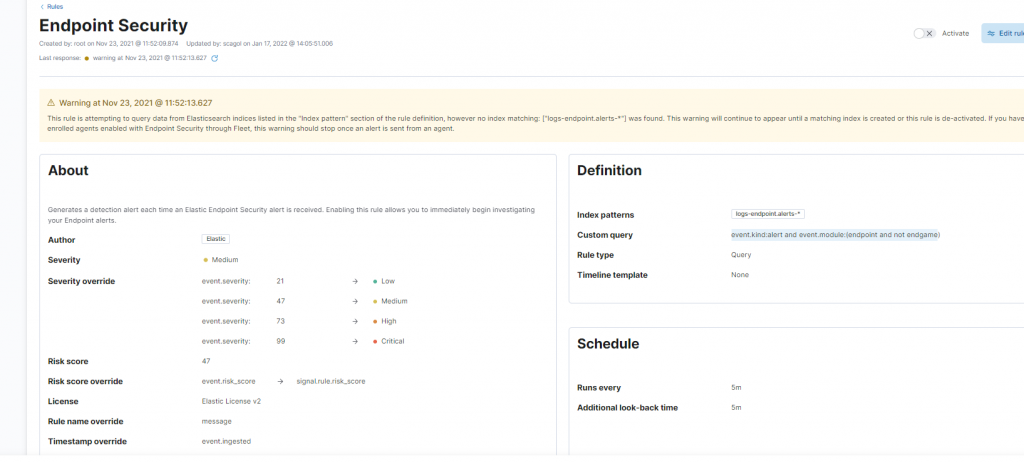
You can also create a dashboard with the details of the situation of the various endpoints present within the infrastructure:
